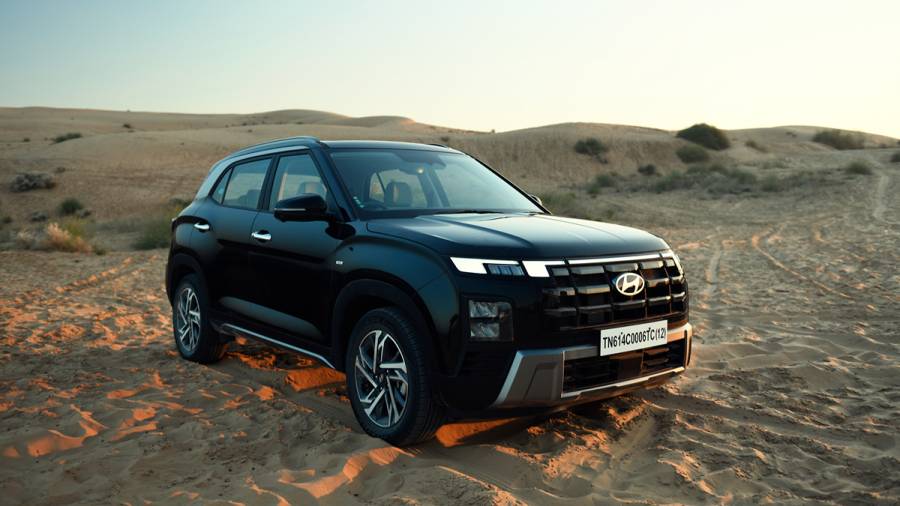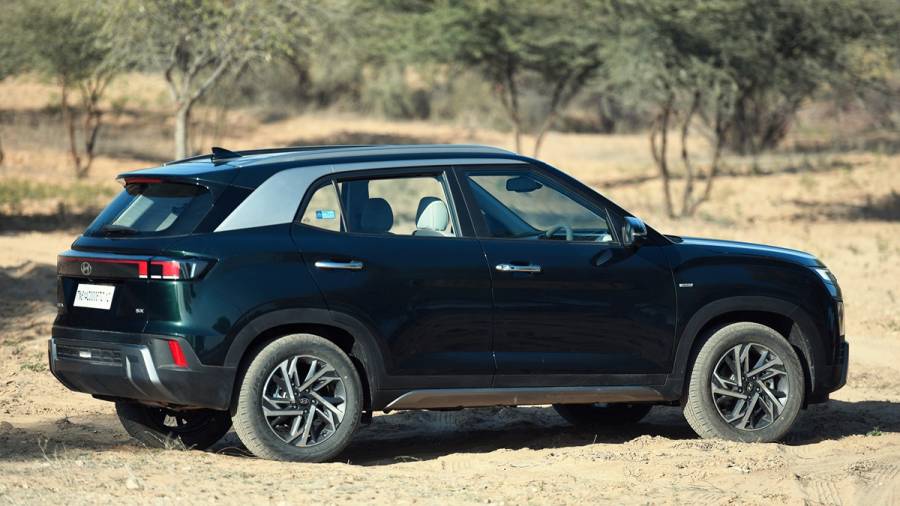2024 Hyundai Creta review, first drive - still the one to beat?
The Hyundai Creta wasn't the first, but it's safe to say that it is the closest that we have to being a default choice for those wanting a mid-sized SUV in India. Since its introduction, over 9 lakh of these have been sold but rivals have never been stronger or offered more differentiated takes on what a family SUV can be. This is why we now have this quite extensive update to the Creta.
2024 Hyundai Creta StylingThis facelift fixes the previous Creta's most contentious aspect, its styling. The new look isn't something that would draw strong opinions but still creates a crisp, modern look that is distinct in this segment. It takes many cues from Hyundai's newest blocky and angular design theme. You see this with the straighter creases on the new bonnet but more so in the large, open grille. We think the full-width LED lighting, now increasingly common among such SUVs, manages to look distinct here with its H-pattern signature.

The quite simple main lighting tempers this, although you still don't get foglamps. Thankfully, the cluster now sits flush with the bodywork and isn't in an indent like in the Verna, so mucky roads will be less of an issue. The new bumper now has the usual air channels for better aero efficiency but otherwise fits right in with the new car's blocky, slightly tough look.
Turn to see the Creat's profile though, and you are left wanting. There hasn't been any change to the sheet metal, so there's little here to discern this from the previous version. A fallout of this also happens to be that the new, angular elements don't fit cohesively into the softer, rounded theme here. You do get a new design for the 17-inch alloy wheels though.

It's better again at the rear again where that crisp, smart look from the front is recreated with the new boot lid and the 3D effect that's been achieved with the full-width lighting. Also well-executed are the sequential indicators both front and back, in the way they remain hidden until they come on. The bumper again adds to the modern tough theme with its large silver elements.
2024 Hyundai Creta Interiors, space and practicalityHere, the new Creta seems to draw some inspiration from the Ioniq 5 and does a good job of recreating that minimal clean atmosphere you find the EV here. The centrepiece of the dash is the floating curve panel with the two 10.25-inch displays. Complementing these is a flat horizontal theme with neatly integrated asymmetric vents and other elements like the small shelf that flows out of the central vents. Paired with the light colour palette it creates a spacious and open feeling in the cabin, quite a departure from earlier. The discreet copper highlights and ambient lighting add to this sense.
But we were left wanting by the lack of soft materials here. Most surfaces, aside from small patches on the doors and centre armrest are hard plastics. We were hoping for further soft surfaces around the dash. Also uncharacteristically for a Hyundai, we found some slightly inconsistent panel gaps around the new dash bits, and flimsy combi switches, which we're hoping will be rectified.
That being said, there's a good deal of functionality packed into the new cabin. The screens are the usual Hyundai-Kia fare, so the driver's display has crisp graphics and a lot of information is accessed easily. But you still don't get wireless Android Auto/Apple Carplay and the wired connection is still through a Type-A port.
But a heartening break from current trends is that there isn't a capacitive touch panel in sight in the new Creta. You get tactile hard buttons for all the audio and climate controls. Taking things further, there are good old-fashioned tuning knobs and toggle switches to make using these functions especially simple on the move. The steering also gets the new gloss buttons but is otherwise quite similar to earlier.
The door panels and central tunnel haven't changed all that much so storage spaces are reasonably good like earlier. A neat touch, again inspired by the Ioniq 5, is the magnetic pad near the driver. It's a fun way to stick on photos or idols instead of on the dashtop.
As for the backseat, things are largely similar. This is no bad thing since the Creta always had enough space for a family of four, with a slightly tight fit for the fifth middle passenger. Most adults will find a good deal of knee, leg and headroom, especially since you can tuck your feet under the front seats.
The seats seem to have been slightly reworked, so there seems to be a touch more under-thigh support than before. The backrest isn't especially contoured so a long journey may turn tiring but some might like the added bolstering on the lower half. The new colours in the cabin also help enhance the sense of space. In terms of amenities here, you get two Type-C charge ports and window shades, aside from the panoramic sunroof.
2024 Hyundai Creta features and safetyThe 2024 Hyundai Creta now gets all the equipment you've come to expect in this segment, bringing it up to speed but not surpassing rivals. So you have full LED lighting, auto headlamps, dual-zone climate control, ventilated seats, panoramic sunroof, powered driver's seat, connected tech, wireless charging and a seven-speaker Bose sound system being the highlights. You still don't get auto wipers and a powered boot lid.
Safety has taken a notable step forward. You can now have the Creta with level 2 ADAS. This Hyundai-Kia system is one of the better-calibrated ones. It's useful in most driving scenarios and never abrupt in its interventions, actually helping you drive better. The clear display and easy access to menus also let you control functions easily on the move. Aside from this, you have six airbags, TPMS, hill-start assist, rear disc brakes, 360-degree cameras, the useful lane watch function and three-point seatbelts for all passengers. A third rear headrest is still missing though.
2024 Hyundai Creta driving impressions 1.5-litre turbo-DCT, 1.5-litre diesel-ATThe 2024 Hyundai Creta now gets the 1.5-litre turbo-petrol, as seen in the Verna and Alcazar. It makes the same 160PS and 253 Nm but is available with the seven-speed DCT only for now. The motor continues to perform similarly here. So it's quite refined at all times and even at higher revs, the drone is a mildly pleasing one.
This motor also delivers performance in an effective way. Yes, there's some hesitation below 2,00 rpm which is most noticeable in stop-and-go traffic but push through and you find a wide and flat powerband that makes for fairly smooth driving. For those inclined to more spirited driving, there is a notable step in performance over 4,000 rpm too. The seven-speed DCt also works intensively here. It won't allow you hard downshifts as in say a Volkswagen, and in the Creta, it seems a touch more efficiency-focused than in the Verna for example. But still, a heavy dab of the throttle usually wakes it up quickly enough for overtakes. In most other situations, it ensures you have a steady stream of performance at your disposal allowing for a fluid driving experience.
Although we think the diesel could be the better choice if performance isn't a top priority for you. The same 1.5-litre unit has been carried over with its 116PS and 250 Nm, paired with a six-speed torque converter. In traffic, it's a mid more fluid with its low-end responses but then flows into that kind of mid-range performance that you expect with such a powertrain. Overtakes and closing gaps in traffic aren't as brisk as the turbo-petrol. But this version of the Creta feels more confident in a steadier high-speed cruise. Helping this trait is the quite commendable levels of refinement.
The six-speed torque converter complements this nature well. It's not the snappiest of its kind but is well-suited to this motor. You usually don't find yourself out of breath, and while there is a slight hesitation when it needs to kick down, the inherent torque of the motor covers for it. As with the DCT, switching to the S mode sharpens things up enough for those looking for a touch more urgency in their driving experience.
But we came away more impressed with the way this Creta moves on the road. Hyundai has reinforced this SUV's structure which has come with an unspecified weight gain. The suspension has also been reworked and this is quite apparent once you've spent some time behind the wheel.
So both versions of the Creta now feel more substantial on the move. There's more solidity here which doesn't fade away even over rough, gravelly tracks. So while larger potholes and broken patches do filter through, they do so with a soft edge that's quite new for the Creta. At higher speeds, this translates into a confident demeanour with the slight skittishness of the earlier SUV much reduced.
If you're familiar with previous Hyundais in general, you'll come away surprised by the new Creta's steering tune. It's usually light at the centre but then becomes quite hefty as you start to turn it. Now this can take a touch more effort in traffic but adds to the sense of solidity on the move. Especially around corners, the new suspension set-up already feels more confident with the steering accentuating this sense, even though there's not much more in the way of feedback.
2024 Hyundai Creta prices, verdict
Prices for the new Hyundai Creat start from Rs 11.00 lakh, going up to Rs 20.00 lakh, which we think is reasonable for what this SUV offers. Although, there could have been more chives for those wanting the turbo-petrol. This new Creta then continues to do what it always has. Unlike its many rivals, it's not strikingly good at one particular thing but instead finds that nice balance that you need in a family car. So there's enough tech and sharp looks for the millennial, enough space and added comfort for the families and now, just the right whiff of engaging driving for one section of enthusiasts. It's not going anywhere soon.
Also read,
2024 Hyundai Creta facelift: Variant-wise features explained
2024 Hyundai Creta facelift launched: Old vs new
2024 Hyundai Creta variant-wise prices